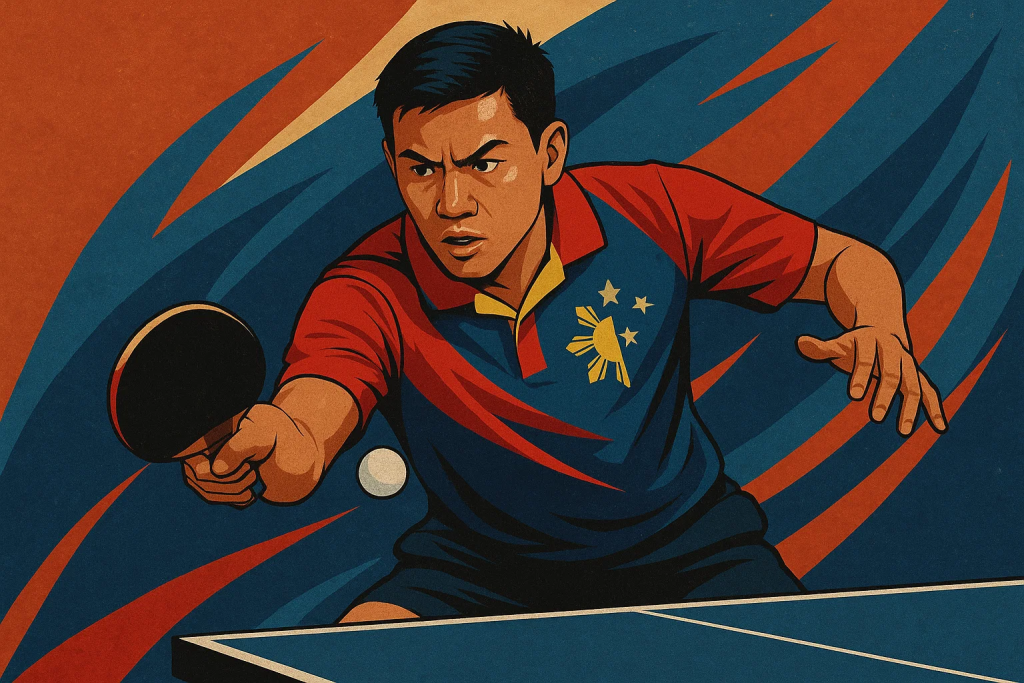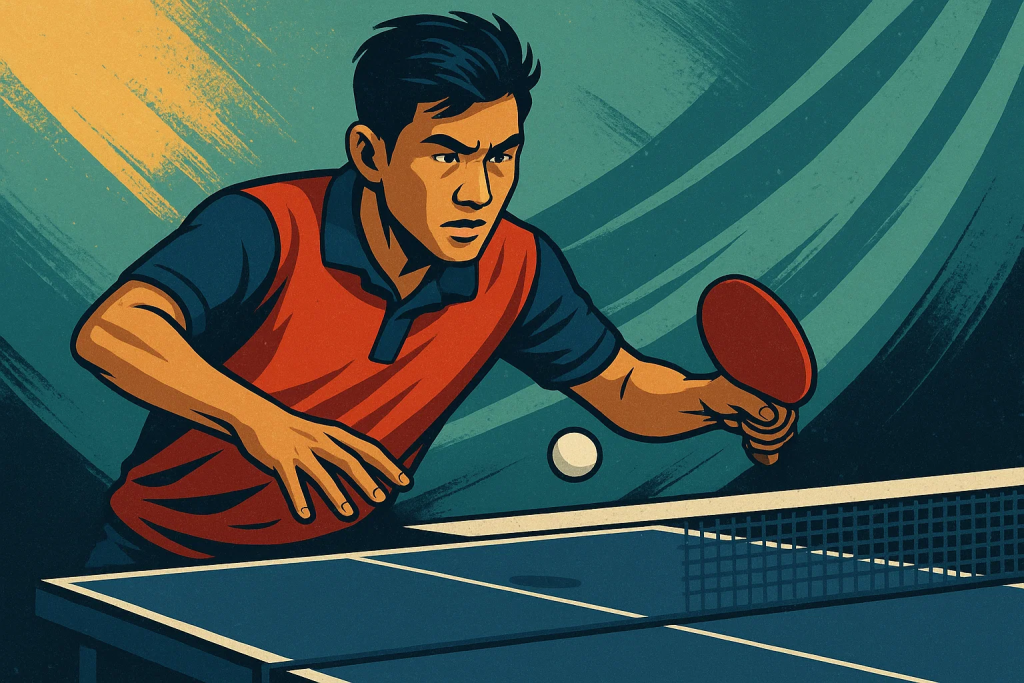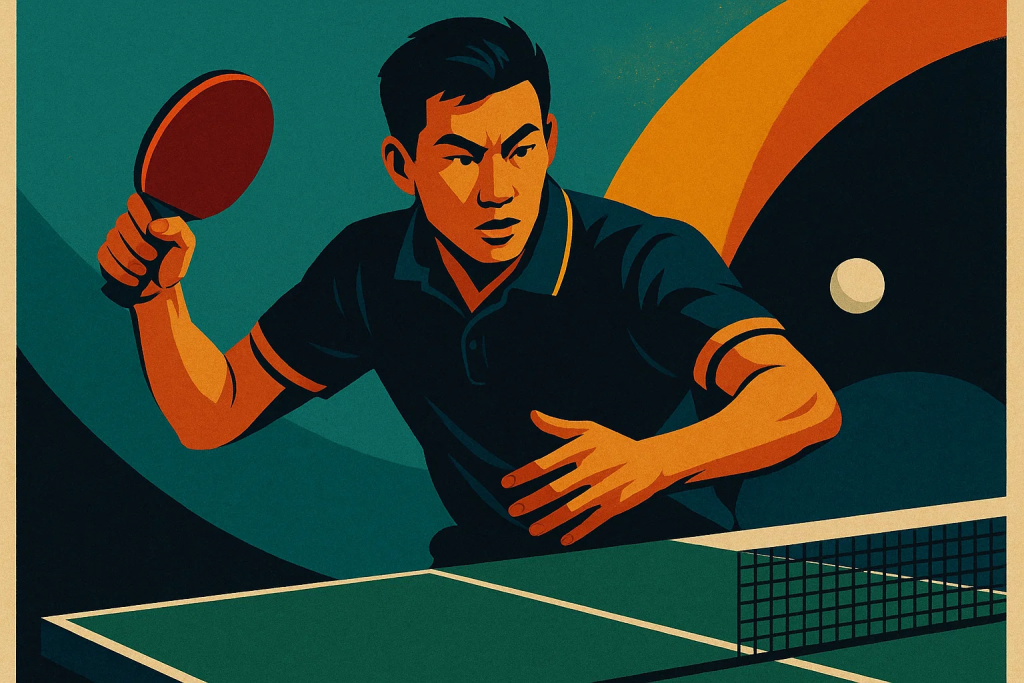Table of Contents
Why tactics in Philippine table tennis are changing (and how to keep up)
Three forces are reshaping table tennis match play across the archipelago:
- The ball and the bounce. Modern 40+ balls reward early timing and line changes more than ultra-spinny, mid-distance rallies. The elite PH response: closer-to-table countering, aggressive over-the-table play, and short-game mastery.
- The lefty/righty mix in local draws. Philippine brackets often feature left-handers in high density—especially in collegiate and corporate leagues. That demands mirrored serve trees, cross-court openers to the elbow, and down-the-line “surprise” lanes.
- Humidity and heat. Tropical courts punish passive touch. Sweat, slower rubbers on sticky days, and softer floors mean players who own the first three strokes and stabilize with compact footwork prevail.
Bottom line: the modern PH game compresses time. Your best upgrade is a codified tactical system—one you can drill and measure.

The seven tactical pillars of the PH elite game
1) Serve architecture: from “good serves” to serve trees
A serve tree is a small family of serves that look alike but produce different spins, arcs, and placements—so you can predict what’s coming back and script your 3rd/5th ball.
Core PH serve tree (right-hander vs right-hander)
- Pendulum short to backhand (BH) — heavy side-underspin, second-bounce near the white line.
- Assumption: passive BH push or soft banana flick.
- 3rd ball: FH loop to the elbow (body) or quick BH punch to the wide BH.
- Reverse pendulum short to forehand (FH) — same toss and rhythm, but side-top or side-under variant.
- Assumption: indecisive short FH push or half-long pop.
- 3rd/5th ball: step-around FH down-the-line to jam the receiver’s crossover.
- Half-long no-spin to middle — deceptive flyer that invites indecision.
- Assumption: late push that floats long.
- 3rd ball: BH topspin off the bounce to wide BH; stay ready for counter.
- Fast long to BH (occasional) — sidespin/side-top at the elbow or wide BH.
- Assumption: rushed BH block.
- 3rd ball: instant line change to FH with BH counter or step-around kill.
Lefty adjustments (and why they win in PH):
Lefties flip the geometry. A lefty’s reverse pendulum short to a right-hander’s FH drives awkward flicks; fast long to the righty elbow steals cheap points. Build two mirrored trees so you never serve into your opponent’s forehand groove twice in a row.
Three serve disguises to practice
- Same toss, three spins: heavy under / no-spin / side-top, identical contact height.
- Depth twin: one serve that lands double-short; its twin with 2–3 cm more acceleration that goes half-long.
- Angle overlay: identical spin but one lands at the elbow, the twin kisses the white line wide BH.
Two PH-specific notes
- Humidity dulls bounce. Keep contact crisp and toss consistent. If your fingers are sweaty, use your towel time to restore feel.
- On dusty floors, serve lower (trajectory < net height + 4–6 cm) to reduce float.
2) Table Tennis Receive systems: win the point before the rally
Elite receivers don’t “react”; they choose from a mini-menu based on server type, depth, and spin guess. Build your receive system around three primary options and two backups.
The PH “3+2” receive menu
- Banana flick (chiquita) to the elbow on any short serve that isn’t loaded under.
- Cue: wristy, over-the-table, topspin arc that dives into the body.
- Follow: be ready for a blocked ball to your backhand—counter or pivot.
- Short touch to FH (for righty vs righty) to break pendulum rhythm.
- Cue: get the second bounce near the net; hide the pace; kill their 3rd-ball plan.
- Active long push to the backhand corner with late, punchy contact on heavy under.
- Cue: create float-no-float ambiguity; aim deep into the white line to force a rushed loop.
Backups
- Hook flip to the wide FH vs reverse pendulum short FH.
- Step-around FH flick vs middle short serves from slow tossers (a PH specialty).
Receive rules that travel
- Always have a default to the elbow on no-spin or readable sidespin.
- On heavy under, if you cannot flick, drop short to the server’s FH; most right-handers struggle to 3rd-ball power from short FH.
- If the serve is half-long, never push long by accident. Either commit to a banana or punch-push deep with intent.
3) Table Tennis First-three-strokes choreography: serve+3rd, receive+4th
Modern PH match winners script their first three contacts like a set piece in futsal.
Right-hander vs right-hander patterns
- S3 (Serve–3rd): Short pendulum BH → soft BH receive → FH 3rd ball to elbow → expect BH block → 5th ball BH down-the-line.
- S3 alt: Half-long no-spin middle → rushed loop at you → BH counter off the bounce to wide BH (catch them moving).
- R4 (Receive–4th): Banana flick to elbow → opponent BH block to your BH → BH counter to wide FH → prepare for cross-court counter, then line change.
Lefty-righty gems
- Lefty short reverse to righty FH → righty pushes short FH → lefty step-around FH flick down the line (open the diagonal instantly).
- Righty banana to lefty elbow → lefty blocks cross to your FH → inside-out FH to their wide FH (trap the crossover).
Golden rule: if you win strokes 1–3 (or 1–4 on receive) 60%+ of the time, you usually win the match, even if your open-rally topspin is average.
4) Table Tennis Rally DNA: early timing, line changes, and two-gear spin
With ABS balls, rallies reward early timing and two-gear spin—one heavier to win initiative, one lighter to gain time and change lines.
- Counter-topspin off the bounce: Take the ball rising; close angle; brush-drive to the open lane.
- Active block with a purpose: Instead of dead blocks, punch-block with mini-side to the opposite of their momentum.
- Two-gear topspin: heavy against a passive block (to shrink their dwell time), then a lighter, faster counter to change line on the next ball.
- Elbow hunting: whenever you see feet crossing, hit body high; most PH players overtrain cross-court and undertrain body defense.
Footwork micro-cues that hold up on dusty floors
- Narrower stance by 1–2 cm on humid days for quicker re-centering.
- Use C-steps (one foot curves, the other recovers) when switching BH→FH close to the table.
- On deep balls, execute one big hop + plant instead of multiple tiny shuffles that slip.
5) Table Tennis Matchups: the new PH solutions vs common styles
a) Short-pips forehand hitters
- Serve heavy under short BH, bait long push, then roll to their elbow (pips hate indecisive balls).
- In rally, loop with lower arc to the body; never feed their wide FH over and over.
b) Choppers/modern defenders
- Two-ball plan: slow heavy loop to BH chop → expect higher return → fast drive to the elbow or short drop.
- Mix in sudden no-spin; choppers overshoot when the ball carries less rotation.
- Don’t forget short game: short-short into a surprise long fast serve breaks rhythm.
c) Anti-spin blockers
- Open with higher arc heavy topspin; on contact, lift more not harder.
- When the anti blocks back, your ball arrives with less spin—step in and hit through the softness.
d) Penhold RPB loopers
- Serve long to the elbow and short to deep FH; penholders love BH diagonal—deny it.
- Banana into their BH, then line-change early to widen their crossover.
e) Lefty loopers (you are righty)
- Default openers to lefty elbow; rally to wide FH then sudden BH line change.
- On receive, short touch to FH to kill their reverse pendulum 3rd-ball.
6) Table Tennis Doubles tactics that win in PH leagues
- Righty–lefty pairing creates natural forehand coverage. Put the lefty second in rotation so forehands meet cross-court more often.
- Serve to set your partner: short to BH draws a BH push/flick toward your partner’s BH—if they have a strong BH open, exploit it.
- Signal placement and spin discreetly; build two serve trees per pair and recycle them by score.
- Middle is gold. In PH doubles, many pairs don’t drill elbow defense; hit body and call “mine” early to avoid hesitation.
7) Data, mindset, and between-point habits
- Track four KPIs: serve effectiveness (% points won on serve), receive quality (how often you neutralize or seize initiative), rally length distribution (0–3, 4–6, 7+), and elbow-target success.
- Rituals: towel time every 6 points; breathe in 4, out 6; one cue word (“early,” “elbow,” or “low”).
- Score-board tactics: at 9-9, serve your best-disguised depth twin (short/half-long pair); on receive, commit to elbow banana unless spin is obviously heavy under.

Table Tennis Training blueprints: sessions, drills, and microcycles
The 90-minute “tactics first” session (club edition)
- 0–10’ Warm-up with purpose: FH–FH, BH–BH, then FH/BH change every two balls to rehearse line changes.
- 10–25’ Serve tree block: 6 minutes per serve variant (pendulum short BH, reverse short FH, half-long middle, fast long BH). Film one angle for toss and contact height.
- 25–40’ Receive menu: partner randomizes among two short serves + one half-long; you must call your choice (banana/touch/punch-push) before contact.
- 40–60’ First-three-strokes patterns:
- Drill A: S3 elbow pattern (serve short BH → FH 3rd to elbow).
- Drill B: R4 banana pattern (banana to elbow → BH counter wide FH).
- 60–75’ Rally DNA: off-the-bounce counters; active block to opposite momentum; two-gear spin sequence (heavy then lighter/faster).
- 75–90’ Set play: 2 games to 11 focusing on KPIs; debrief 3 notes each.
Multiball progressions (high-reps, low words)
- Banana under pressure: coach feeds random short left/middle/right with spin variety; you call “B” or “T” (banana or touch) before the ball crosses the net.
- Elbow hunt: coach feeds blockable balls to BH/FH; every third ball must hit the elbow.
- No-spin recognition: coach alternates under / no-spin short; you must flick only on no-spin.
Four-week tactical microcycle
- Week 1 – Serve/receive build: 70% short game; set baselines for serve effectiveness and receive quality.
- Week 2 – First-three-strokes: add scripted S3/R4; measure 0–3 rally wins.
- Week 3 – Matchups: dedicate two sessions each to short-pips and lefty patterns; rehearse elbow lines.
- Week 4 – Pressure week: score-based drills (start at 8–8); film two matches and tally KPIs.
Table Tennis Footwork and S&C for humid Philippine courts
- Micro-hops with banded resistance: teach soft landings and quick re-centering on dusty floors.
- C-step ladders: cone to cone with FH→BH transitions, cue “land-load-launch.”
- Posterior-chain strength: hip hinge work (Romanian deadlifts), split squats, calf–Achilles capacity (eccentric calf raises).
- Plyometrics: low-dose pogo jumps and lateral bounds; always earn the right to jump by owning slow strength first.
- Recovery: 7–8 hours sleep, 20–30 minutes easy cycling on off-days, and heat management (cooling towels, hydration plan).
Table Tennis Equipment choices for PH conditions (no brand hype, just parameters)
- Blade speed: all-wood OFF- to composite OFF- offers enough pace with better dwell for countering close to table.
- Rubber hardness: medium to medium-hard on BH for active block and banana stability; medium on FH if you prefer early-timing counters.
- Tack vs grip: mildly tacky FH helps on humid days for opening loops; grippy euro-jap BH supports punch-block and banana.
- Sponge thickness: max or 2.1–2.2 mm on FH for power; 1.9–2.1 mm on BH for control if you over-hit under pressure.
- Maintenance: wipe dust with a slightly damp microfiber between games; swap to a fresh dry shirt after Game 2 to keep hands and handle dry.
Table Tennis Scouting cheat-sheet: read opponents in five points or fewer
- Serve tell: watch their toss height and contact sound; harsher click often = less spin/shallower brush.
- Receive bias: do they default to push on short FH? If yes, serve there and claim 3rd-ball attacks.
- Crossover speed: send two fast balls FH→BH; slow feet reveal an elbow target all match.
- Backhand honesty: test BH counter with a firm drive; if they block passive, you can camp at the table.
- End-game nerves: at 9–9, many players revert to their first serve ever practiced; be ready for that exact spin again.
Mental game: Philippine-tested routines in Table Tennis
- One-breath rule: exhale fully before serve receive; call your target out loud (“elbow,” “short FH”).
- Score framing: break every game into two mini-games (0–5, 6–11); reset focus at 5.
- Error taxonomy: after every miss, label it read / swing / feet and fix one variable on the next ball.
- Between-match reset: 2 minutes eyes-closed visualization of your best three points from past wins.
Case study snapshots (fictionalized, but pattern-true)
- College righty looper hits a plateau vs pips hitters. After four weeks of elbow-first patterns and low-arc drives, his win rate vs pips flips from 30% to 65%.
- Club lefty keeps losing deciders at 9–9. She adds a depth-twin serve and an elbow-banana default; clutch points turn into a strength.
- Corporate league pair (righty-lefty) starts signaling serve outcomes and aiming more balls to middle. They win their division without adding speed—only clarity.
Troubleshooting: quick fixes to common PH Table Tennis problems
- “My banana dies on humid days.” Raise your elbow, shorten your backswing, brush earlier; switch to a slightly grippier BH rubber or freshen topsheet.
- “Opponents pick on my elbow.” Practice split-step earlier; drill BH→FH transitions with C-steps; keep your chest square longer.
- “I serve short but they flip easily.” Serve lower with later acceleration; add a no-spin twin off the same toss to sour their timing.
- “I can’t read reverse pendulum.” Default to short FH touch until you decode the side direction; review video at 0.25× speed to spot the wrist change.
Call-to-action: build your PH Table tennis elite playbook this month
You don’t need a training camp to play like the PH table tennis elite—you need a playbook you trust. This week, pick:
- One serve tree (4 variants).
- One receive menu (3 primaries, 2 backups).
- Two first-three-strokes patterns (S3 + R4).
- One matchup focus (lefty, pips, or chopper).
- Two KPIs to track in every session.
Run the 90-minute session twice, tally your KPIs, and post your results to your team chat or club board. If this guide helped, challenge a training partner to try the same five-point plan and compare notes. Tactics compound when shared.

FAQs: PH Table Tennis Elite & New Ping-Pong Tactics
1) What’s the single biggest tactical upgrade for club players in the Philippines?
Build a serve tree with two short, one half-long, and one fast serve that all share the same toss and rhythm. Script the third ball for each. The improvement in free points and weak returns dwarfs most equipment changes.
2) How do I stop left-handers from dictating rallies?
Serve more to the lefty elbow and short to the lefty FH to kill their reverse pendulum pattern. On receive, banana to elbow as your default. In rallies, open to wide lefty FH, then change line early to the BH.
3) Is the banana flick essential for PH competition?
Yes, because it punishes short no-spin or light side-spin serves that are common at local level. Even a medium banana to the elbow neutralizes many 3rd-ball attacks and keeps you close to the table, where the ABS ball favors you.
4) What equipment tweaks help in hot, humid gyms?
Choose grippy (not overly tacky) topsheets, keep a dry towel for hands and handle, and consider a slightly firmer BH sponge for stabler bananas and active blocks. Wipe your rubber during towel breaks to clear sweat dust.
5) How should doubles pairs structure practice?
Drill serve-receive to set your partner, practice balls to middle, and rehearse one righty–lefty rotation even if you’re both right-handed (switch positions after every serve). Add a simple signal system and keep your serve trees to two per player for clarity under pressure.
